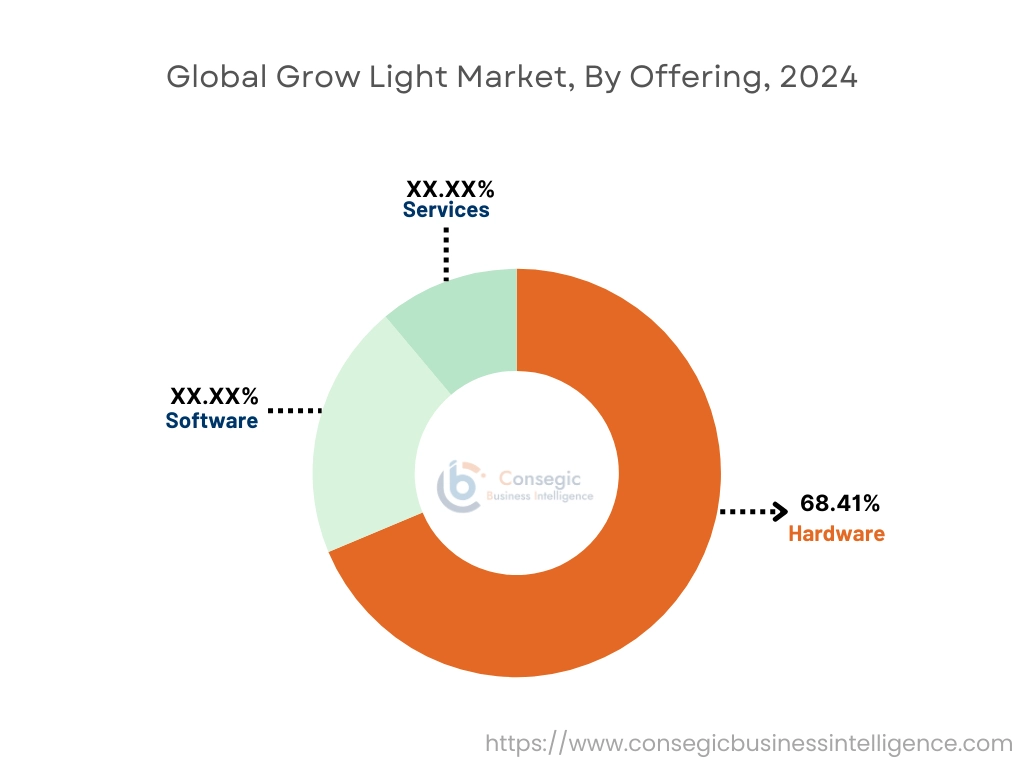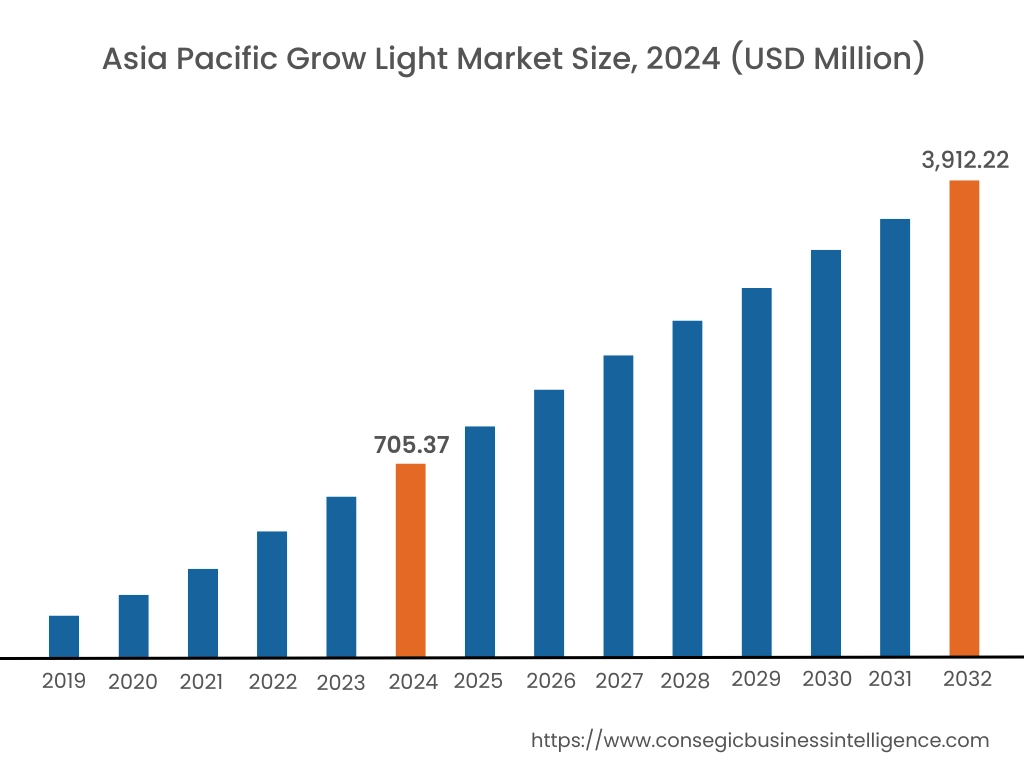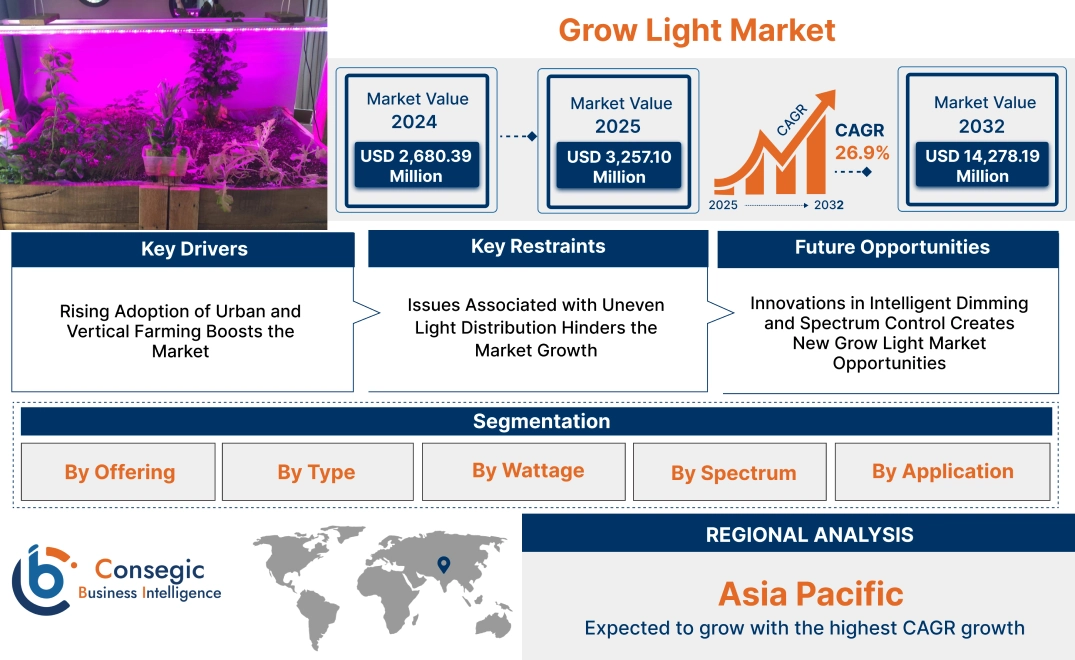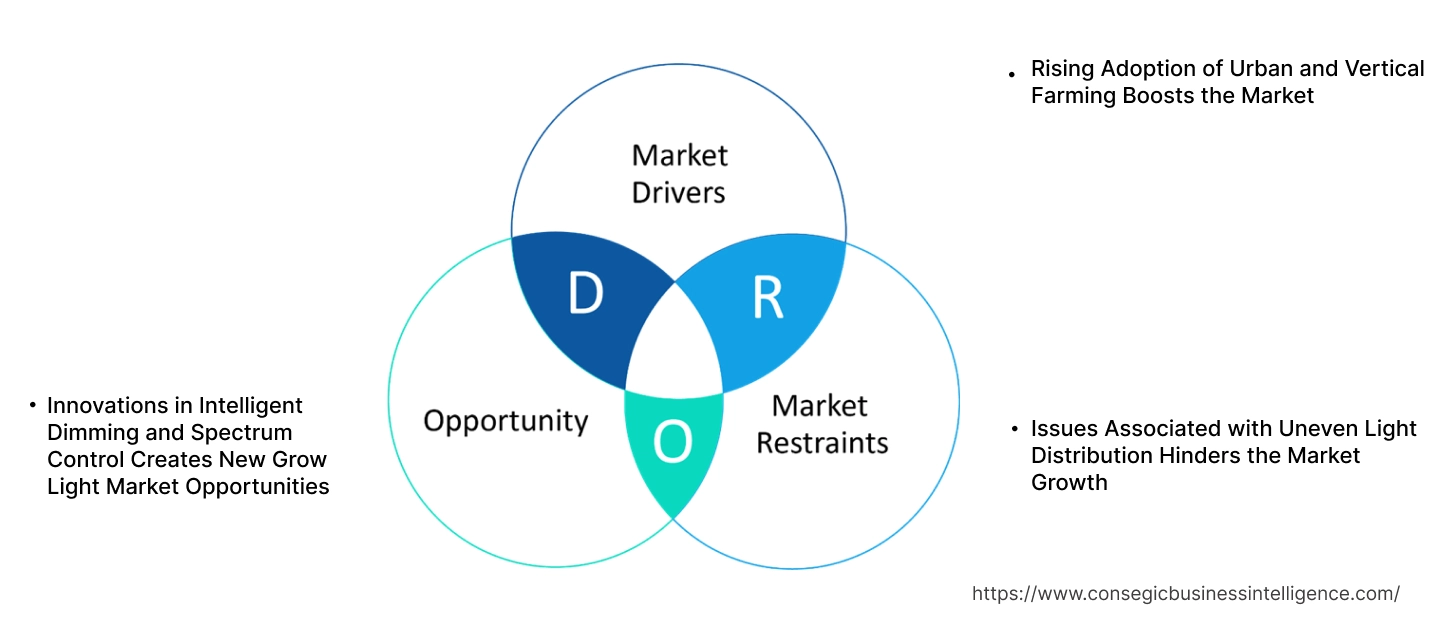Grow Light Market Size:
Grow Light Market size is estimated to reach over USD 14,278.19 Million by 2032 from a value of USD 2,680.39 Million in 2024 and is projected to grow by USD 3,257.10 Million in 2025, growing at a CAGR of 26.9% from 2025 to 2032.
Grow Light Market Scope & Overview:
Grow lights are a substitute for natural sunlight assisting in plant growth. These lights are energy efficient, produce high yields, and support the full life cycle of plants. Moreover, these lights can be controlled as per the needs of the diverse plants. These lights are available in full spectrum and partial spectrums. The plants that grow best under these lights include leafy greens, herbs, microgreens, tomatoes, and peppers. Additionally, these lights are used in indoor farming, vertical farming, urban farming, aquaponics, hydroponics, and greenhouses, among others.
How is AI Impacting the Grow Light Market?
AI algorithms analyze data from sensors monitoring plant health, environmental conditions, and light spectrum efficiency, allowing grow lights to dynamically adjust their output. Also, AI-powered systems monitor plant growth, adjust light spectrum, and optimize energy consumption, leading to higher yields and more sustainable practices. This includes smart sensors, AI algorithms, and automated systems for manufacturing and maintenance. Further, the ability to fine-tune light conditions leads to healthier plants, faster growth, and higher overall crop yields.
Key Drivers:
Rising Adoption of Urban and Vertical Farming Boosts the Market.
Growing crops in urban areas in controlled environments to provide fresh yield closer to consumers is primarily attained through urban and vertical farming. These techniques use less space and produce high yields. Urban and vertical farming techniques allow consumers to produce fresh yield locally. Grow lights are used in urban and vertical farming to control and provide lighting for photosynthesis. This increases the quality and yield generated. Moreover, these lights are energy efficient and are available in customizable solutions for specific plants.
- For instance, the US Department of Agriculture stated that urban farming contributes to 15-20% of the global food supply. This denotes the large yield generated using urban farming.
Thus, the aforementioned factors are boosting the adoption of these lights, which is further turn driving the market.
Key Restraints:
Issues Associated with Uneven Light Distribution Hinders the Market Growth
The improper placement and adjustment of grow lights lead to uneven light distribution. This causes inconsistent growth and impacts the appearance of plants.
Similarly, issues associated with uneven light distribution also causes inconsistent growth in a series of plants, leading to improved nourishment of some plants and lack of nourishments in certain plants. Moreover, this also causes leaf burn, reduced yield, poor flowering, and elongation of certain parts of plants. Thus, the market analysis shows that the aforementioned factors are restraining the grow light market demand.
Future Opportunities :
Innovations in Intelligent Dimming and Spectrum Control Creates New Grow Light Market Opportunities
Integration of smart controllers and sensors to control the light spectrum and intensities enables intelligent dimming and spectrum control of lights. Smart controllers adjust the power output according to environmental factors. Moreover, automatic spectrum controls enable automatic adjustment of the light wavelength and spectrum considering the stage of life cycle of the plant, and other factors.
- For instance, in September 2024, Sollum announced the SUNaaS platform. It uses artificial intelligence for automatic real-time dimming based on light variations.
Thus, the market analysis depicts that the ongoing advancements in these lights are projected to drive grow light market opportunities during the forecast period.
Grow Light Market Segmental Analysis :
By Offering:
Based on the offering, the market is segmented into hardware, software, and services.
Trends in the Offering:
- Rising adoption of grow lights to boost the yield is driving the market demand.
- There is an increasing trend towards the adoption of grow lights for energy efficiency in vertical and urban farming.
The hardware segment accounted for the largest revenue share of 68.41% in the market in 2024.
- The hardware includes lights and accessories including power cords, sockets, plug adapters, dimmer controllers, and PAR meters, among others.
- These components enable light intensity control, spectrum change, maintenance, and repairs of lights.
- For instance, Fluortronix offers IOT app-controlled LED lights in its product offerings. This 500W LED light utilizes a full spectrum and has a lifespan of 80,000 hours.
- Therefore, grow light market analysis shows that the increasing advancements associated with these lights are driving the market trends.
The services segment is expected to register the fastest CAGR during the forecast period.
- The services include installation, setup, maintenance, repair, troubleshooting, light selection, and light spectrum customization.
- Different life stages of plants require different services. Moreover, the equipment requires constant maintenance for efficient operation.
- For instance, Intelligent Horticultural Solutions (IHS) offers several horticultural LED lights. It offers a customizable solution with an LED mix and accessories.
- Thus, the benefits offered by these services are driving the adoption of these lights, in turn propelling the grow light market growth during the forecast period.

By Type:
Based on the type, the market is segmented into light emitting diode (LED), fluorescent, incandescent, high-intensity discharge (HID), and others.
Trends in the Type:
- Rising adoption of fluorescent lights for seedlings as they are readily available and affordable.
- Increasing shift towards adoption of incandescent lights as it is the cheapest option available in the market.
The high-intensity discharge (HID) segment accounted for the largest revenue in the grow light market share in 2024.
- High-intensity discharge lights offer better light output and brightness. These lights are made up of two electrodes filled inside special gas-filled bulbs.
- These lights are available in two types including metal halide (MH) and high-pressure sodium (HPS).
- For instance, Valoya offers a HPS light solution. This solution works best for warehouse cultivation environments and greenhouses.
- Therefore, the grow light market analysis depicts that the benefits offered by HID lights are driving the market demand.
The LED segment is expected to register the fastest CAGR during the forecast period.
- LED lights produce significantly less heat compared to HID lights. These lights use less air conditioning and require less maintenance.
- LED lights are used in confined spaces or vertical farming. LED lights are suitable for adjustable spectrums and offer lower operating costs in the long term.
- For instance, Soltech Solutions offers Grove LED light in its product offerings. This light is suitable for indoor plants and herbs.
- Thus, the benefits offered by LED lights are further driving their adoption, in turn boosting the grow light market expansion during the forecast period.
By Wattage:
Based on the wattage, the market is segmented into below 100W, 100 to 1000W, and above 1000W.
Trends in the Wattage:
- Rising adoption of lights below 100W for indoor plants and small spaces is boosting the market demand.
- Increasing shift towards the adoption of lights above 1000W for commercial spaces including greenhouse farming are driving the grow light market size.
The 100 to 1000W segment accounted for the largest revenue in the market in 2024 and it is also expected to register the fastest CAGR during the forecast period.
- The lights within a range of 100 to 1000W are capable of delivering a power output of the given range. These lights are mostly used for mid-sized projects or spaces.
- These lights have higher intensity, which enables faster plant growth in monitored conditions. These lights offer maximum efficiency when placed appropriately over the plant canopy.
- For instance, in January 2022, AB Lighting announced a new grow light. This new lighting has a lifespan of over 50,000 hours and 520W input power.
- Therefore, the increasing innovations related to these lights within a range of 100 to 1000W are driving the market expansion.
By Spectrum:
Based on the spectrum, the market is segmented into full and limited.
Trends in the Spectrum:
- Rising adoption of limited spectrum lights for dedicated lighting for specific growth cycles of plants.
- Increasing adoption of full spectrum lights for facilitating full life cycle of plants is boosting the grow light market demand.
The limited spectrum segment accounted for the largest revenue share in the grow light market share in 2024.
- The limited spectrum lights emit only a narrow range of wavelengths within the visible light spectrum, primarily providing certain colors including red or blue.
- These lights are used for targeted growth stages and are not ideal for all plants. These lights promote certain characteristics including leafy growth or flower production.
- Therefore, the market analysis shows that the benefits offered by limited spectrum lights are driving the grow light market size.
The full spectrum segment is expected to register the fastest CAGR during the forecast period.
- The full spectrum lights emit a broader range of visible light wavelengths. These lights resemble white sunlight.
- Full spectrum lights provide lighting for the overall growth of plants. Moreover, full spectrum lights are flexible and they are used for various plants in different stages of development.
- For instance, in May 2022, Spectrum King LED introduced full spectrum LED lightning Phoenix. Is suitable for cannabis and indoor agriculture.
- Thus, the increasing advancements associated with full spectrum lights are projected to boost the grow light market trends during the forecast period.
By Application:
Based on the application, the market is segmented into indoor farming, vertical farming, urban farming, greenhouse farming, hydroponics, aquaponics, and others.
Trends in the Application:
- Rising adoption of grow lights in hydroponics due to their ability to provide a mix of light intensities and wavelengths.
- Increasing trend towards the adoption of grow lights for indoor farming to provide lighting solutions for indoor plants.
The greenhouse farming segment accounted for the largest revenue share in the market in 2024.
- Grow lights are used in greenhouse farming to increase plant yields and quality.
- These lights are used during winter months when the sunlight is limited and help to cultivate plants that do not thrive solely on natural light.
- For instance, in February 2025, California LightWorks launched the MegaDrive UnderCanopy light system for greenhouse farming. The features of this system include a centralized power supply, waterproof design, and optimized light spectrum.
- Therefore, market analysis depicts that wide applications of lights in greenhouse farming are driving the grow light market growth.
The vertical farming segment is expected to register the fastest CAGR during the forecast period.
- In vertical farming, plants rely on grow lights for photosynthesis, as there is less exposure to sunlight due to stacked layers.
- Moreover, these lights assist in plant growth by targeting specific growth cycles using different light intensities and wavelengths.
- For instance, in June 2024, Ryan Growing Systems introduced the Inaro horticultural light for vertical farming. This lighting solution is customizable and affordable.
- Thus, the application of these lights in vertical farming is projected to drive the grow light market trends during the forecast period.
Regional Analysis:
The regions covered are North America, Europe, Asia Pacific, the Middle East and Africa, and Latin America.

Asia Pacific region was valued at USD 705.37 Million in 2024. Moreover, it is projected to grow by USD 860.08 Million in 2025 and reach over USD 3,912.22 Million by 2032. Out of this, China accounted for the maximum revenue share of 31.8%. The market in the Asia-Pacific region is experiencing fast growth due to the increasing pace of urbanization and rising need for efficient solutions in greenhouses to produce high yields.
- For instance, in August 2023, Signify, a grow LED light manufacturing company, launched its largest light manufacturing plant in China. This facility has 192 production lines with advanced manufacturing technology and process controls.
- Moreover, in January 2023, Polymatech Electronics introduced the next-generation horticulture LED light. These products are useful for greenhouses, horticulture, and vertical farming.

North America is estimated to reach over USD 4,340.57 Million by 2032 from a value of USD 806.96 Million in 2024 and is projected to grow by USD 981.38 Million in 2025. In the region, the market is rising due to the usage of these lights in vertical farming, indoor farming, and aquaponics projects.
- For instance, in December 2022, AeroGarden, a US-based company, launched indoor grow lights for house plants. These lights are customizable and are connected to the app allowing users to control the lights.
Additionally, in Europe, the market is experiencing steady growth, attributing to its well-established urban and vertical farming industry in the region. In Latin America, the market is rising due to rising disposable income, leading to indoor farming practices. Further, in the Middle East and Africa, there is a surge in aquaponics and hydroponics projects, which is further facilitating the grow light market expansion.
Top Key Players & Market Share Insights:
The grow light industry is highly competitive with major players providing solutions to the national and international markets. Key players are adopting several strategies in research and development (R&D), product innovation, and end-user launches to hold a strong position in the global grow light market. Key players in the grow light industry include -
- Vivosun (US)
- Valoya (Finland)
- Vertically Urban (UK)
- Fluortronix Innovations Pvt. Ltd (India)
- Nexsel Tech (India)
- One Stop Grow ShopLimited (UK)
- Sevad Ltd (UK)
- DAYLIGHT Lighting Systems (UK)
- Signify Holding. (UK)
- Future Garden (UK)
Recent Industry Developments :
Product Launches:
- In September 2024, FOHSE launched PRO series LED lighting technology. This series offers an array of seven adjustable spectrums.
Acquisitions:
- In December 2023, Acuity Brands announced the agreement to acquire Current Lighting Solutions LLC’s Azire segment of horticulture lighting products. This acquisition aims to expand the lighting offerings previously offered by the company.
Grow Light Market Report Insights:
| Report Attributes | Report Details |
| Study Timeline | 2019-2032 |
| Market Size in 2032 | USD 14,278.19 Million |
| CAGR (2025-2032) | 26.9% |
| By Offering |
|
| By Type |
|
| By Wattage |
|
| By Spectrum |
|
| By Application |
|
| By Region |
|
| Key Players |
|
| North America | U.S. Canada Mexico |
| Europe | U.K. Germany France Spain Italy Russia Benelux Rest of Europe |
| APAC | China South Korea Japan India Australia ASEAN Rest of Asia-Pacific |
| Middle East and Africa | GCC Turkey South Africa Rest of MEA |
| LATAM | Brazil Argentina Chile Rest of LATAM |
| Report Coverage |
|
Key Questions Answered in the Report
How big is the grow light market? +
Grow Light Market size is estimated to reach over USD 14,278.19 Million by 2032 from a value of USD 2,680.39 Million in 2024 and is projected to grow by USD 3,257.10 Million in 2025, growing at a CAGR of 26.9% from 2025 to 2032.
What are the major segments covered in the grow light market report? +
The segments covered in the report are offering, type, wattage, spectrum, and application.
Which region holds the largest revenue share in 2024 in the grow light market? +
Europe holds the largest revenue share in the grow light market in 2024.
Who are the major key players in the grow light market? +
The major key players in the market are Vivosun (US), Valoya (Finland), One Stop Grow Shop Limited (UK), Sevad Ltd (UK), DAYLIGHT Lighting Systems (UK), and Signify Holding. (UK), Future Garden (UK), Vertically Urban (UK), Fluortronix Innovations Pvt. Ltd (India), and Nexsel Tech (India).



